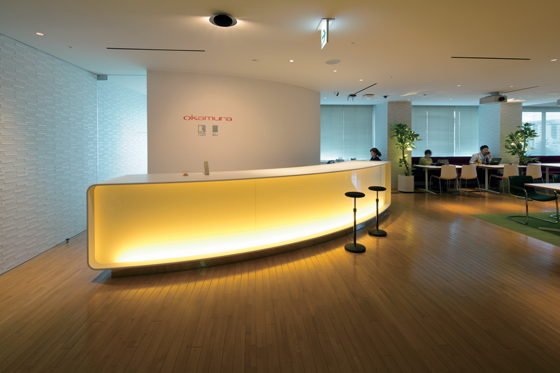Furniture That Works With You
Brand story by Simon Keane-Cowell
Tokyo, Japan
27.01.14
Almost 70 years in business and forward-thinking Japanese manufacturer OKAMURA, renowned for, among other products, its super-engineered office furniture, shows no sign of taking its eye off the ball of innovation. Sit up straight, people.
A clever ring structure, visible on the backs of the chairs in Okamura's 'Sabrina' series, ensures the user receives continuous support regardless of the direction in which they stretch, while lending the furniture a distinctive aesthetic presence
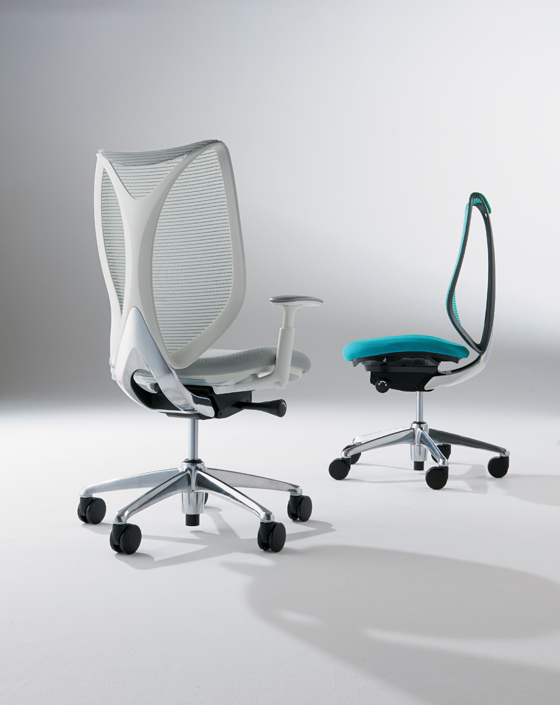
A clever ring structure, visible on the backs of the chairs in Okamura's 'Sabrina' series, ensures the user receives continuous support regardless of the direction in which they stretch, while lending the furniture a distinctive aesthetic presence
בWhat Was Good Design?’ asked New York’s Museum of Modern Art in its popular 2011 exhibition. The presence of the upper case here – ‘Good Design’, rather than ‘good design’ – together with the use of the past tense are clues enough to suggest that the show’s title is referring to something other than the notion of design that’s, well, good.
Indeed, what MoMA is examining here is the movement that first came to light in the 1930s, but gained greater traction in the immediate post-war period – one which sought to change the material landscape of the everyday by rethinking the objects we use in the home, office and beyond, making them easier to use and more effective, while maintaining their aesthetic value. State-funded design councils, museums and stores all acted as Good Design ambassadors, promoting these bold, progressive goods to a new generation of consumers.
Okamura's 'Sabrina' series of task chairs, designed by Giugiaro Design, feature the company's innovative ankle-tilt mechanism, whereby the seat element sinks back and downwards in perfect sync with the backrest as the latter tilts back

Okamura's 'Sabrina' series of task chairs, designed by Giugiaro Design, feature the company's innovative ankle-tilt mechanism, whereby the seat element sinks back and downwards in perfect sync with the backrest as the latter tilts back
×Founded right after the end of the Second World War, respected Japanese manufacturer Okamura counts both as historical actor in the Good Design movement and as contemporary design brand whose products could be regarded almost as text-book definitions of what good design is. Having lost his job in aeroplane manufacturing, entrepreneurial Okamura founder Kenjiro Yoshihara started out in business in 1945, transferring his expert knowledge of steel to the fabrication of products large and small, from airplanes and automobiles, through outdoor furniture, to pots and pans. From the outset, a passion for materials and craftsmanship was central to the Okamura company philosophy. (In case you’re wondering, the company is named after the place where it was founded, in Yokohama City.)
Innovators from the start: Okamura was responsible for producing post-war Japan's first domestic plane, the N-52, launched in 1953

Innovators from the start: Okamura was responsible for producing post-war Japan's first domestic plane, the N-52, launched in 1953
×That golden age of design, the 1950s, was a decade of firsts for the pioneering manufacturer, which launched Japan’s first post-war domestic plane, the N-52, along with the Mikasa, the country’s first front-wheel-drive automatic car, the latter aided in no small part by the company’s innovative production of torque converters for both industrial and consumer vehicles. Parallel to this, Okamura set out to rethink some of the key furniture typologies that we encounter in our daily lives. Set against the backdrop of Japan’s remarkable post-war economic recovery, it launched the ‘Type-36’ office desk in 1955, followed two years later by its ‘LowBoy’ shelving, originally designed for US armed-forces bases in Japan.
The early years of Okamura saw the company innovate in a number of product sectors, including automobiles. The Mikasa, the country’s first front-wheel-drive automatic, was launched in 1957

The early years of Okamura saw the company innovate in a number of product sectors, including automobiles. The Mikasa, the country’s first front-wheel-drive automatic, was launched in 1957
בWhat all of these have in common,’ explains Ayano Sando from Okamura’s International Sales and Marketing Division, ‘is a familiarity with steel and our passion for moving parts. Moving parts require complex technology, and a passion for technology has always been at the centre of Okamura’s craftsmanship.’ You may not immediately think ‘moving parts’ when considering furniture, but then again Okamura isn't just your generic furniture manufacturer. With a steadfast commitment to research at its core, the brand has since those early years made ergonomics a keystone of its design activity. Just as the human body is a compelling piece of engineering, not short on moving parts, so too are Okamura's office-chair designs, which set out, through their exemplary understanding of, as the company puts it, 'the relation between people and chairs', to both support the user's body while seated and moving through a range of different positions, and to actively encourage good posture.
The 'Leopard' series of chairs support the user's every sitting and standing movement with continous comfort and no need for adjustment

The 'Leopard' series of chairs support the user's every sitting and standing movement with continous comfort and no need for adjustment
×In the history of the science of human-factors engineering, Okamura were quick off the mark, launching their ergonomics-embracing 'Type-22' chair in 1961, which, specified widely in Japanese offices, went on to become a long-seller for the company. In the intervening decades, an increasing body (if you’ll excuse the pun) of research has been published that underscores what we, essentially, have always known: that our emotional states – that is, how we feel about and perceive ourselves and our abilities – is bound up to a large extent with our physical well-being. Recent studies have shown, moreover, that the adoption of certain poses produces chemicals in the body that make us more confident and alert. Whatever the science, Okamura were early to recognise this interconnection and have established themselves as leaders in the field for developing seating products that optimise the nexus of bodily movement, comfort, concentration and safety.
Greater than the sum of its parts: Okamura's chairs are super-engineered, to deliver both flexibility and support. Rigorous testing ensures they are up to their job

Greater than the sum of its parts: Okamura's chairs are super-engineered, to deliver both flexibility and support. Rigorous testing ensures they are up to their job
×1992 saw the launch of Okamura’s ‘FC-9’ chair, which was the first outing of the manufacturer’s game-changing ankle-tilt reclining mechanism. Here, the act of leaning backwards tilts the backrest, as one would expect, but, in an impeccable synchronicity, the seat element also sinks back and downwards. This ground-breaking design, which cleverly dovetails with the user’s movements, guarantees not only exceptional comfort through an effective distribution of weight, it also allows you to recline – gradually opening up the ankle, knee and hip joints – without moving the position of the ankles. The benefits are both physical and mental: on the one hand, an improvement in blood circulation through the body, and on the other longer periods of concentration that are uninterrupted by sensations of discomfort or the need to alter your seating position. In short, Okamura’s innovation works with you while you work.
‘We always keep our eyes open to what workers want,’ says Okamura's Ayano Sando. Shown here, the company's OfficeLab in Tokyo...
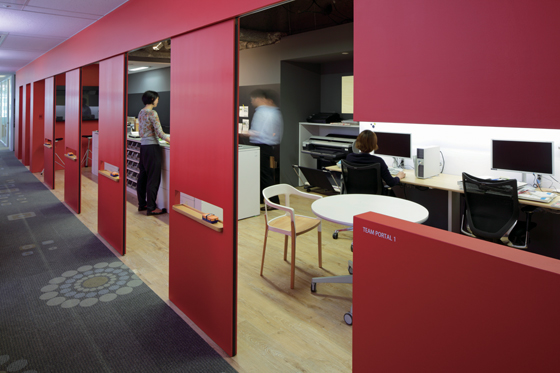
‘We always keep our eyes open to what workers want,’ says Okamura's Ayano Sando. Shown here, the company's OfficeLab in Tokyo...
×...and the Okamura Chair Museum, which opened in 2009
Given the success of Okamura’s ankle-tilt mechanism, it’s no wonder the manufacturer has applied it to its subsequent chair models. The new ‘Sabrina’ series is no exception. Born out of the company’s established relationship with Giugiaro Design (headed up by renowned Italian automobile designer, Giorgetto Giugiaro – those moving parts again!), this is the fourth product to result from their close collaboration. The chairs in the series have a close connection, too, according to Ayano Sando. Like family. ‘The “Sabrina” series has two sisters,’ she explains. ‘The older sister, the fully modelled “Sabrina Smart Operation”, which was first launched at Orgatec in 2012. And then the younger sister, the more reasonably priced “Sabrina Standard”, which was launched in 2013 at 100% Design in London.”
A continuous commitment by Okamura to innovation and an awareness of the changing needs of workers has guaranteed its products' wide specification in offices the world over
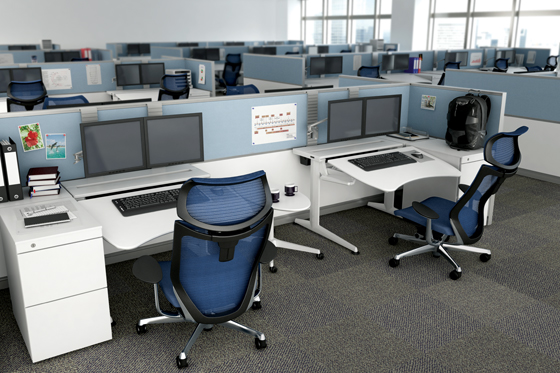
A continuous commitment by Okamura to innovation and an awareness of the changing needs of workers has guaranteed its products' wide specification in offices the world over
×Their common DNA is identifiable on both technical and aesthetic levels. Both models permit two effects simultaneously – fix and flex. The former allows you to maintain the S-shape of your spine while sitting (which is its correct posture), while the latter supports you when you stretch, bending in tandem with you, leftwards and rightwards. This dual performance is thanks to the chairs’ ring structure, which defines the backs of the chairs visually, ensuring their confident aesthetic presence. Like Paris’s Pompidou Centre, the ‘Sabrina’ series – indeed, all of Okamura’s super-engineered task chairs – make a visual virtue of their construction, confidently foregrounding the way in which they’re built. ‘For us, comfort, ergonomics and design aren’t at odds with each other, but interconnect,’ says Sando. ‘If a product is comfortable to use, then it is a good design. If a product is well-designed, then it has a high level of comfort.’ Both of the ‘Sabrina sisters’ deliver strongly on these two fronts, with ‘Sabrina Standard’ responding to the need on the part of customers to reduce costs where possible. ‘For us, compromising the creativity and performance of workers is the last thing we want. That’s why we created “Sabrina Standard”, which is more easily within reach, but still has a strong design presence and a high comfort.’
Soft mesh and 'smart operation' ergonomics – which include easy adjustment from a seated position thanks to intuitively designed armrest levers – guarantee high levels of comfort to users of Okamura's 'Contessa' chair

Soft mesh and 'smart operation' ergonomics – which include easy adjustment from a seated position thanks to intuitively designed armrest levers – guarantee high levels of comfort to users of Okamura's 'Contessa' chair
×It’s this kind of holistic thinking – not only in terms of its research and design, but also in the way it operates across different environments (the company offers high-quality products and fixtures for public spaces such as schools, theatres and museums, as well as for retail displays, to mention just a few of its specialisms) – that has become a hallmark of the Okamura brand. Just as their chairs mould themselves around the bodies of their users, so the Japanese manufacturer monitors the changing needs of the workforce as closely as possible. ‘We always keep our eyes open to what workers want,’ says Sando. ‘And what they want today is to have choices. They want to choose how, when and where to work, based on what they have to do at any specific time. As a manufacturer, we really need to respond to this.’
With almost 70 years in business, it’s clear that Okamura won’t be taking a challenge like this sitting down.
Ayano Sando from Okamura's International Sales and Marketing Division: ‘If a product is comfortable to use, then it is a good design. If a product is well-designed, then it has a high level of comfort'
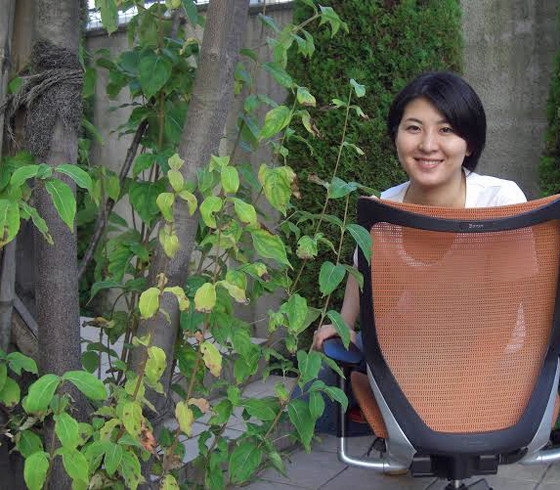
Ayano Sando from Okamura's International Sales and Marketing Division: ‘If a product is comfortable to use, then it is a good design. If a product is well-designed, then it has a high level of comfort'
×












